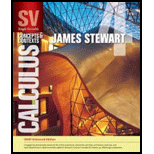
Concept explainers
(a) Apply Newton’s method to the equation x2 − a = 0 to derive the following square-root algorithm (used by the ancient Babylonians to compute √a):
xn+1=12(xn+axn)
(b) Use part (a) to compute √1000 correct to six decimal places.
(a)
To Derive: The algorithm for the square root of the given equation by Newton’s method.
Answer to Problem 23E
The derivation is xn+1=12(xn+axn)
Explanation of Solution
Given:
The equation is x2−a=0.
Formula used:
The Newton’s method is xn+1=xn−f(xn)f′(xn).
Calculation:
Let f(x)=x2−a and obtain the derivative of f(x).
Let the derivative of f′(x)=df(x)dx.
f′(x)=d(x2−a)dx=d(x2)dx−d(a)dx=2x−0=2x
To derive the xn+1 use the above mentioned formula.
xn+1=xn−x2n−a2xn=2x2n−x2n+a2xn=x2n+a2xn=12(xn+axn)
Hence, the derivation.
(b)
To Compute: The root of √1000 correct to six decimal places by using part (a).
Answer to Problem 23E
The root correct to six decimal places is 31.6227762.
Explanation of Solution
Given:
The equation is x2−a=0.
Choose the initial point x1=30.
Calculation:
Calculate f(x1) at the point x1=30 and a=1000.
f(30)=(30)2−1000=900−1000=−100
Calculate f′(x1) at the point x1=30.
f′(30)=2×30=60
Substitute n=1 in the above mentioned result in part (a) and obtain x2
x2=12(x1+ax1)
Substitute x1=30,f(x1)=−100 and f′(x1)=60.
x2=30−(−100)60=30+10060=30+1.666666≈31.666666
Calculate f(x2) at the point x2=31.666666 and a=1000.
f(31.666666)=(31.666666)2−1000=1002.777735−1000=2.777735
Calculate f′(x2) at the point x2=31.666666.
f′(31.666666)=2×31.666666=63.333332
Substitute n=2 in the above mentioned result in part (a) and obtain x3.
x3=12(x2+ax2)
Substitute x2=31.666666,f(x2)=2.777735 and f′(x2)=63.333332.
x3=31.666666−2.77773563.333332=31.666666−0.043859≈31.622807
Calculate f(x3) at the point x3=31.622807 and a=1000.
f(31.622807)=(31.666666)2−1000=1000.001924−1000=0.001924
Calculate f′(x3) at the point x3=31.622807.
f′(31.622807)=2×31.622807=62.666664
Substitute n=3 in the above mentioned result in part (a) and obtain x4.
x4=12(x3+ax3)
Substitute x3=31.622807,f(x3)=0.001924 and f′(x3)=62.666664.
x4=31.622807−0.00192462.666664=31.622807−0.000030≈31.6227762
Thus, the root corrected to six decimal places is 31.6227762_.
Chapter 4 Solutions
Single Variable Calculus: Concepts and Contexts, Enhanced Edition
- For each graph in Figure 16, determine whether f (1) is larger or smaller than the slope of the secant line between x = 1 and x = 1 + h for h > 0. Explain your reasoningarrow_forwardPoints z1 and z2 are shown on the graph.z1 is at (4 real,6 imaginary), z2 is at (-5 real, 2 imaginary)Part A: Identify the points in standard form and find the distance between them.Part B: Give the complex conjugate of z2 and explain how to find it geometrically.Part C: Find z2 − z1 geometrically and explain your steps.arrow_forwardA polar curve is represented by the equation r1 = 7 + 4cos θ.Part A: What type of limaçon is this curve? Justify your answer using the constants in the equation.Part B: Is the curve symmetrical to the polar axis or the line θ = pi/2 Justify your answer algebraically.Part C: What are the two main differences between the graphs of r1 = 7 + 4cos θ and r2 = 4 + 4cos θ?arrow_forward
- A curve, described by x2 + y2 + 8x = 0, has a point A at (−4, 4) on the curve.Part A: What are the polar coordinates of A? Give an exact answer.Part B: What is the polar form of the equation? What type of polar curve is this?Part C: What is the directed distance when Ø = 5pi/6 Give an exact answer.arrow_forwardNew folder 10. Find the area enclosed by the loop of the curve (1- t², t-t³)arrow_forward1. Graph and find the corresponding Cartesian equation for: t X== y = t +1 2 te(-∞, ∞) 42,369 I APR 27 F5 3 MacBook Air stv A Aa T 4 DIIarrow_forward
- Middle School GP... Echo home (1) Addition and su... Google Docs Netflix Netflix New folder 9. Find the area enclosed by x = sin²t, y = cost and the y-axis.arrow_forward2. Graph and find the corresponding Cartesian equation for: (4 cos 0,9 sin 0) θ ε [0, 2π) 42,369 I APR 27 3 MacBook Air 2 tv A Aaarrow_forward30 Page< 3. Find the equation of the tangent line for x = 1+12, y = 1-3 at t = 2 42,369 APR A 27 M . tv NA 1 TAGN 2 Aa 7 MacBook Air #8arrow_forward
 Calculus: Early TranscendentalsCalculusISBN:9781285741550Author:James StewartPublisher:Cengage Learning
Calculus: Early TranscendentalsCalculusISBN:9781285741550Author:James StewartPublisher:Cengage Learning Thomas' Calculus (14th Edition)CalculusISBN:9780134438986Author:Joel R. Hass, Christopher E. Heil, Maurice D. WeirPublisher:PEARSON
Thomas' Calculus (14th Edition)CalculusISBN:9780134438986Author:Joel R. Hass, Christopher E. Heil, Maurice D. WeirPublisher:PEARSON Calculus: Early Transcendentals (3rd Edition)CalculusISBN:9780134763644Author:William L. Briggs, Lyle Cochran, Bernard Gillett, Eric SchulzPublisher:PEARSON
Calculus: Early Transcendentals (3rd Edition)CalculusISBN:9780134763644Author:William L. Briggs, Lyle Cochran, Bernard Gillett, Eric SchulzPublisher:PEARSON Calculus: Early TranscendentalsCalculusISBN:9781319050740Author:Jon Rogawski, Colin Adams, Robert FranzosaPublisher:W. H. Freeman
Calculus: Early TranscendentalsCalculusISBN:9781319050740Author:Jon Rogawski, Colin Adams, Robert FranzosaPublisher:W. H. Freeman
 Calculus: Early Transcendental FunctionsCalculusISBN:9781337552516Author:Ron Larson, Bruce H. EdwardsPublisher:Cengage Learning
Calculus: Early Transcendental FunctionsCalculusISBN:9781337552516Author:Ron Larson, Bruce H. EdwardsPublisher:Cengage Learning





